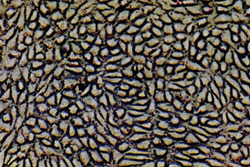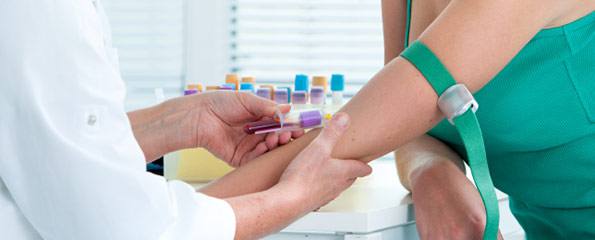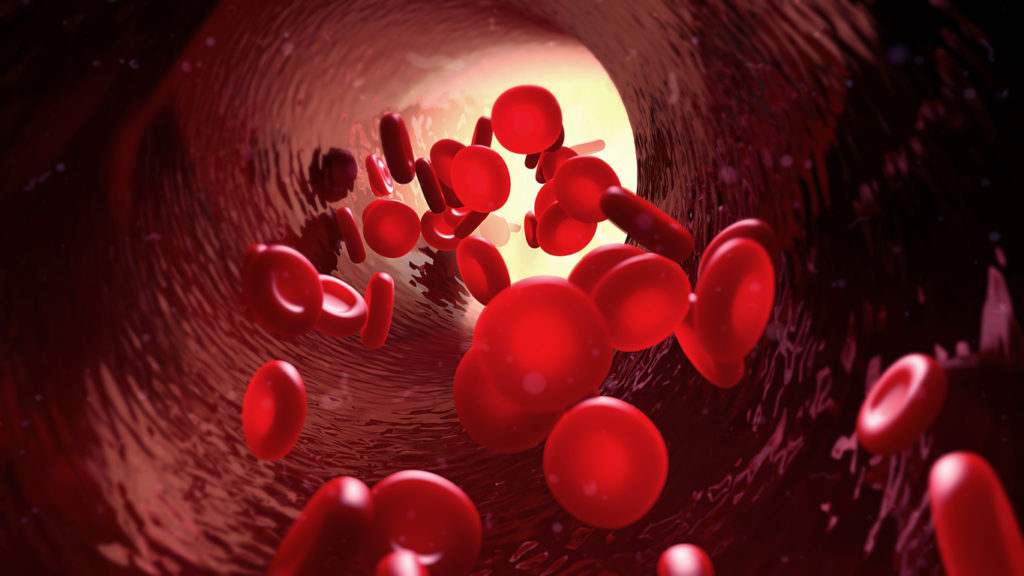Endothelial cell structure

Endothelial cell function
The endothelium can be divided up into three distinct functional surfaces:
- The non-thrombogenic luminal surface to the blood and its constituents;
- A cohesive junctional surface that modulates the passage of molecules and cells;
- An adhesive abluminal surface capable of interacting with subendothelial structures and peivascular tissues.
The endothelium has multiple functions that can be briefly summarised as follows:
The endothelium is a selectively permeable barrier, meaning that it allows certain substances to pass through it while preventing others from passing. It therefore helps regulate both immune and inflammatory responses.
Several transendothelial transport mechanisms are thought to exist. The main mechanisms are intercellular clefts and pinocytosis.
Angiogenesis (formation of new blood vessels)
Angiogenesis is the formation of new blood vessels, and is particularly important in the development of the embryo, where the formation of initial vasculature is critical to the growth of the embryo beyond a few millimetres. Further understanding how blood vessels grow and develop is also useful in cancer treatment research.
Endothelium is normally a slow growing tissue. However, this growth rate increases in area where blood flow is turbulent and in patients with hypertension. When damaged, any exposed subendothelium (the layer directly beneath the endothelium) is covered by adjacent endothelial cells within 30 minutes. Not only are endothelial cells mobile, they are capable of phagocytosis, the process of ingesting substances including bacteria. Clinically, the successful revascularisation of grafts and sterns is only possible because of these remarkable regenerative powers.
It is essential that blood does not normally clot in the vasculature, and this attribute is dependent on an intact endothelium which has an anticoagulant surface. Paradoxically, blood is required to clot, in a controlled fashion, if a vessel is damaged. Thromboregulation therefore also contributes to repair mechanisms and involves endothelial expression of cells and molecules associated with coagulation.
These include vasodilators (causing the vessels to dilate) such as nitric oxide and powerful vasoconstrictors (causing the vessels to constrict) such as endothelin.
Endothelial cells express and/or release a wide variety of other molecules including growth factors, enzymes, adhesion molecules and other receptors.
Endothelial cells normally express the major (ABO) blood groups and Class I (HLA-A, B) histocompatibility antigens. On stimulation by immune cells such as T cells, endothelial cells also express Class II (Ia) histocompatibility antigens and can act as antigen-presenting cells.
Because endothelium possesses so many diverse and critical functions, there has developed an important appreciation of the possible consequences of endothelial dysfunction. These include changes affecting structure, growth, permeability and the regulation of coagulation, inflammation and vasomotor activity. It is also now increasingly realised that many of the beneficial cardioprotectant effects of exercise may be mediated by the endothelium, with increased physiological blood flow promoting endothelial cell health.
References
- Cohnheim J. Lectures on General Pathology. London: New Sydenham Society; 1882.
- Virchow R. Phlogose ung thrombose in gefessystem. Gesammelte Abhandlungen zur wissenschaftlichen medicine. Frankfurt-am-Main: Meidinger Sohn and Company; 1856.
- Jaffe EA, Nachman RL, Becker CG, Minick CR. Culture of human endothelial cells derived from umbilical veins: Identification by morphological and immunological criteria. J Clin Invest. 1973;52:2745-56.
- Jaffe EA. Physiologic functions of normal endothelial cells. Ann N Y Acad Sci. 1985;454:279-91.
- Gimbrone MA Jr. Vascular endothelium: Nature’s blood container. In: Gimbrone MA Jr (ed). Vascular Endothelium in Haemostasis and Thrombosis. New York: Churchill Livingstone; 1986. pp. 1-13.
- Gerlach E, Nees S, Becker BF. The vascular endothelium: A survey of some newly evolving endothelial biochemical and physiological features. Basic Res Cardiol. 1985;80:459-74.
- Stemerman MB, Colton C, Morell EM. Perturbations of the Endothelium. In: Spaet TH (ed). Progress in Hemostasis and Thrombosis. Orlando: Grune and Stratton; 1984. pp. 289-324.
- Cao Y, Langer R. A review of Judah Folkman’s remarkable achievements in biomedicine. Proc Natl Acad Sci USA. 2008;105(36):13203-5.
- Schwartz SM, Benditt EP. Clustering of replicating cells in aortic endothelium. Proc Natl Acad Sci USA. 1976;73:651-3.
- Ryan US, Schultz DR, Goodwin JD, Vann JM, Selvaraj MP, Hart MA. Role of C1q in phagocytosis of Salmonella minnesota by pulmonary endothelial cells. Infect Immun. 1989;57(5):1356-62.
- Furchgott RF, Zawadzki JV. The obligatory role of endothelial cells in the relaxation of arterial smooth muscles by acetylcholine. Nature. 1980;288:373-6.
- Palmer RM, Ferrige AG, Moncada S. Nitric oxide release accounts for the biological activity of endothelium-derived relaxing factor. Nature. 1987;327:524-6.
- Yanagisawa M, Kurihara H, Kimura S, Tomobe Y, Kobayashi M, Mitsui Y, et al. A novel potent vasoconstrictor peptide produced by vascular endothelial cells. Nature. 1988;332:411-5.
- Ryan US, Whitney PL, Ryan JW. Localization of carbonic anhydrase on pulmonary artery endothelial cells in culture. J Appl Physiol. 1982;53(4):914-9.
- Pober JS, Gimbrone MA Jr, Cotran RS, Reiss CS, Burakoff SJ, Fiers W, et al. Ia expression by vascular endothelium is inducible by activated T cells and by human gamma interferon. J Exp Med. 1983;157(4):1339-53.
- Marsh SA, Coombes JS. Exercise and the endothelial cell. Int J Cardiol. 2005;99(2):165-9.
All content and media on the HealthEngine Blog is created and published online for informational purposes only. It is not intended to be a substitute for professional medical advice and should not be relied on as health or personal advice. Always seek the guidance of your doctor or other qualified health professional with any questions you may have regarding your health or a medical condition. Never disregard the advice of a medical professional, or delay in seeking it because of something you have read on this Website. If you think you may have a medical emergency, call your doctor, go to the nearest hospital emergency department, or call the emergency services immediately.






